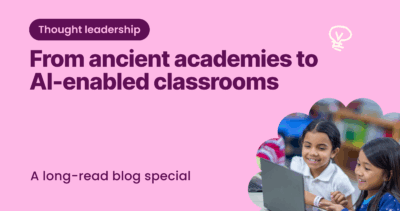
Shirin Bradfield
The concept of the collaborative classroom can feel a bit like an ill-defined buzzword – surely there are elements of collaboration going on in lessons every day?
In fact, collaborative learning is a systematic approach to encouraging deep thinking and knowledge sharing amongst students. Not only is this super exciting, but it is also much easier to achieve in the age of powerful and portable educational technology!
The collaborative classroom offers a seismic shift away from the victorian teaching fashion of rote learning and strictly directed individual activity. Instead, it empowers students to guide each other and think critically about concepts by engaging with peers – awesome right?
But this inspiring end result won’t happen simply because you’ve set a group activity. It requires careful implementation and development.
We are going to dive into the world of the collaborative classroom and get to the bottom of exactly what it involves, why it’s important and how you can create it in your learning environment.
Five Cooperative Learning Activities for The First Day of Schoolhttps://t.co/rhn1e55uo6 pic.twitter.com/xj5dHI4eMO
— Kami (@KamiApp) August 31, 2017
What is collaborative learning?
“So I want more interaction, for students to sort of collaborate better and support everyone’s learning…” you find yourself saying in the staffroom to increasingly blank looks. Summing up the elements of a collaborative classroom is a tricky task, largely because it is a complex concept that taps deep into educational theory. Let’s have a go at nailing the idea:
The notion of collaborative learning is derived from the work of Lev Vygotsky’s all the way back in 1920. His theory of the ‘zone of proximal development’ highlights that there is typically a segment of tasks that learners cannot accomplish alone. However, with some guidance, they can not only complete the task but learn how to repeat it alone. Within this zone, learning through interaction and communication is essential in order to access higher levels of critical thinking and knowledge about the task.
The modern concept of collaborative learning holds two central ideas:
- It’s through dialogue and interaction that curriculum objectives come truly alive for students.
- A group can accomplish meaningful learning and solve problems better than any individual can alone.
The collaborative classroom has four key characteristics:
1. Shared knowledge
In traditional classrooms, knowledge usually travels in one direction – from teacher to student. In a collaborative classroom, the emphasis is on knowledge sharing. So educators still possess the vital subject expertise and provide this information to students. However, there is an equal emphasis on cultivating the knowledge, personal experiences, and culture that students bring to the classroom.
2. Shared authority
Traditionally, responsibility for setting goals, designing learning tasks, and assessing what is learned is given entirely to the teacher (or other powers that be). Collaborative learning encourages students to decide on their own goals within the framework of what is being taught. This allows them to suggest activities or assignments that capture their interests and goals and to assess what they learn. There is also a great emphasis on listening to others and treating differing opinions and claims with respect and patience – rather than adhering to a structure of clear right and wrong.
3. Mixed student grouping
The aim is to share as much knowledge and experience as possible, so it makes sense to group students with a variety of skill sets and cultural backgrounds. It’s important to note that traditional ‘ability’ segregation is actively discouraged, as no student should be deprived of the opportunity to make contributions and appreciate the contributions of others. Similarly, the nature of collaboration is that everyone has something to learn from each other, regardless of perceived academic success.
4. Teachers as mediators
Knowledge and authority is shared among teachers and students, so the role of teacher should increasingly take the form of mediator rather than director. As a mediator, you will help students to connect new information to their own experiences, give assistance when a group gets stuck and provide guidance on how to learn. The aim is to adjust the level of support and information to maximize students’ ability to take responsibility for their own learning. This runs contrary to a spoon feeding approach where you distill and give all the information to students ready for them to simply absorb.
Why should you create a collaborative classroom?
Collaborative learning offers students many tangible benefits that are crucial for success in the work environment and life in general. Some of the most essential are:
Critical thinking
Collaborative learning is considered part of a ‘thinking curriculum’. Basically, this means it teaches students how to learn things for themselves and think critically about concepts at a high level. The lack of spoon-feeding knowledge and incorporation of debate and discussion allows children to analyze subjects more deeply and how they fit in relation to other areas.
The ability to analyze information and understand it at a high level is essential for most jobs and also a vital skill for navigating the digital world and mainstream media.
Enhances problem-solving
A collaborative classroom environment places responsibility on students to drive their own learning and find solutions to problems with the help of their peers. The move away from passive interaction with knowledge creates more need to work together and solve new obstacles.
Develops communication skills
At the center of collaborative learning is the need to work as a team and encourage each other. This requires students to develop their listening skills and learn to value everybody’s contributions. This builds vital social skills, a sense of community and confidence in each other.
Another important element of this group development is the ability to respectfully disagree with peers. Rather than rubbishing points of view or ignoring them, collaborative learning gives students the tools to reach a group decision.
How can you create a collaborative classroom?
The benefits of a collaborative learning environment are clear, but creating this form of sophisticated classroom teamwork can be daunting. It is true that a shift to a totally collaborative way of working will take plenty of planning and adaption – officially known as scaffolding. However, many elements of the collaborative model can be worked into all sorts of lesson plans in order to build these vital skills amongst students.
Here are some strategies you can incorporate to foster collaborative learning in your classroom:
Create a community agreement
Establishing group rules and etiquette from the get-go is an important step in creating accountability and feeling of student responsibility. Creating a document or statement of all the actions the group agrees to take, lays down some clear guidelines to help collaboration. It can also be helpful to establish some roles within the group to maintain the agreement and keep everyone on task. These roles may vary depending on the task, for example, investigator, discussion director and recorder in the case of an analysis exercise.
Teach cooperation skills
It’s nice to believe that these skills are inherent, but anyone whos seen a group activity descend into an argument (this goes for adults as well as kids!) knows this isn’t the case. Like most other competencies, cooperation skills need to be taught. This includes vital abilities like:
- Listening: Good listeners are rare but invaluable for true teamwork. Making rules such as ‘three before me’ where at least three others must share before someone speaks again can help aid this.
- Asking thoughtful questions: Interesting questions are the basis for investigation and critical thinking. Encouraging students to consider what they need to know about a topic and how to structure questions to get the best response is important.
- Negotiation: It’s rare that a group will unanimously agree on one solution or answer, so it’s vital that students learn how to work towards agreement and compromise.
Design your classroom
Effective collaboration requires flexibility. Group working can require anything from open space, and writing areas, to access to information, privacy and specialized tools. Traditional static or formulaic classroom designs can limit the extent to which easy collaboration can occur.
1:1 devices with a good range of flexible education applications can be very helpful in supporting this form of cooperative learning. Using devices, educators are free to move amongst their students, casting their screens whilst simultaneously gaging how everyone in the class is progressing. This breaks front to back lecture hall classroom arrangement. Instead, each student can access the necessary information on their own device from anywhere in the room. Digital documents can also be accessed, produced and annotated collaboratively, so feedback and discussion can naturally take place.
Collaboration can be tough to initiate, particularly if you don’t have the right tools at your disposal. The Kami app provides the fundamental apparatus needed to create an engaging and cooperative learning environment. With Kami as your digital pen and paper, teachers and students can achieve more together. Learn more about how Kami could help your collaborative classroom today.
You may also like

From ancient academies to AI-enabled classrooms

Improving AI literacy in American schools

